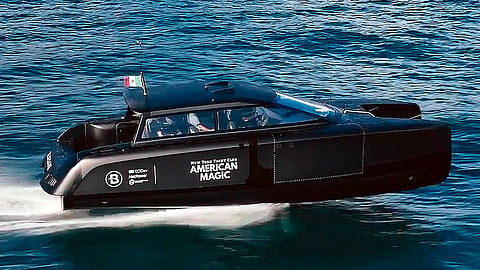VESSEL REVIEW | BGH – Hydrogen yacht chase boat with long endurance and 50-knot top speed
Bluegame, a subsidiary of Italian builder Sanlorenzo Yachts, has introduced a new hydrofoil catamaran chase boat fitted with a hydrogen propulsion system. Designed with input from naval architects Philippe Briand and Mirko Oprandi, BGH has been handed over to US-based professional yacht racing team American Magic, which will operate it as a support vessel during the America’s Cup races.
The 10-metre (33-foot) BGH boasts lightweight carbon construction and advanced hydrofoil technology, enabling it to “fly” across the water at speeds of up to 50 knots. The hydrogen propulsion system provides a maximum zero-emission range of just over 120 nautical miles, thus ensuring the vessel has the endurance necessary to operate as a support boat for long races and offshore events.
The need to sail at high speeds for sustained periods called for a solution with a greater capability than what batteries could achieve, even in the case of foiling catamarans, due to the heavy weight and the volume occupied by such batteries. Calculations have shown that either the boat could not fly, as it is too heavy, or it could not satisfy performance requirements, as lighter batteries would not provide enough power and would drain too quickly.
Hybrid propulsion setup for greater flexibility
The new boat also needed to be capable of generating zero emissions, which was not possible for a vessel fitted with a traditional internal combustion engine. As with other hydrogen-powered vessels, the chase boat’s only emission is water.
Finally, a catamaran design was selected since it ensures that a smaller overall hull area comes into contact with the water before foiling takes place, thus helping minimise the vessel’s energy consumption over the same sailing distances.
The operating principle behind the chase boat is that it will rely on its hydrogen fuel cells to maintain a cruising speed of 35 knots. Batteries with a total rated output of 190 kWh are also fitted, but their use will be limited only to operating in boost mode – when additional propulsive power is needed – thus ensuring they do not drain too quickly.
A power management system will handle the vessel’s power requirements based on the ideal configuration to achieve maximum range. It will also balance the use of power coming from the fuel cells with the energy stored in the batteries, though the fuel cell can also be used to recharge the batteries if needed.
First in a new low-emission vessel series
The fuel cells are fed by four tanks that each contain up to eight kg of hydrogen compressed at 350 bar. These will ensure an endurance of 3.5 hours. When combined with the 190 kWh from the batteries, an hour is added to the maximum endurance and the range is extended to 150 nautical miles.
Bluegame intends to commercialise its fuel cell technology and is already planning the launch of a new line of hydrogen-powered yachts, with the first model scheduled to be launched in 2025. The company is also preparing to deliver a second BGH-series chase boat to the Orient Express Racing Team, the official French team that participates in the America’s Cup.


